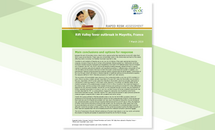Rapid risk assessment: Rift Valley fever outbreak in Mayotte, France
This rapid risk assessment (RRA) addresses the risk of importation of Rift Valley fever (RVF) virus (RVFV) and further spread of the virus within the European Union/European Economic Area (EU/EEA) in relation to the recent increase in cases reported on Mayotte, France.
Executive Summary
Between the end of November 2018–1 March 2019, regional authorities reported 82 human Rift Valley fever (RVF) cases across Mayotte. These cases are concentrated mainly in the Centre-West and North of the island, affecting mainly rural areas. No fatalities have been reported to date.
Travellers to and residents of Mayotte are at very low risk of infection if they apply appropriate preventive
measures. Those who are in contact with potentially infected animals (e.g. veterinarians and those involved in livestock farming, butchering and slaughtering of animals in RVF-affected areas) have an increased risk of infection with RVF virus and should ensure safe animal husbandry and slaughtering practices
The current outbreak in Mayotte poses a very low risk for EU/EEA countries in terms of introduction of RVF through the animal trade, as imports into the continental part of the EU of live animals and their meat and milk from Mayotte are probably very rare, due to the distance. The illegal transport of fresh meat and unpasteurised milk and untreated products from infected ruminants in personal luggage can pose a risk.
Should the virus be introduced into continental EU/EEA through imported infected animals, further vector-borne transmission among animals cannot be excluded. However, the likelihood is very low during the winter season due to the low-level abundance and activity of competent mosquito vector populations in continental EU/EEA countries.
Download





